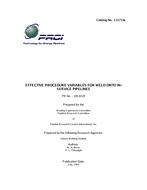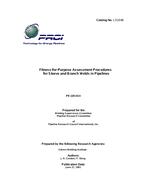Provide PDF Format
PRCI PR-185-9329
- Effective Procedure Variables for Weld Onto In-Service Pipelines
- Report / Survey by Pipeline Research Council International, 07/01/1994
- Publisher: PRCI
$198.00$395.00
L51713e
Edison Welding Institute
Need: The ability of the flowing contents to remove heat from the pipe wall causes welds made onto in-service pipelines to cool at an accelerated rate and makes these welds particularly susceptible to hydrogen cracking. Several approaches exist for qualifying procedures where the thermal conditions produced by the flowing pipeline contents are simulated, allowing the ability of a procedure to produce sound, crack-free welds to be demonstrated.
Benefit: This report documents the various methods that can be used, under a number of different conditions, for simulating the proper cooling effects that will be experienced when welding on in-service pipelines. Three candidate methods were selected and evaluated based on their simplicity and their ability to produce realistic weld cooling rates. Several field trials were undertaken in conjunction with actual in-service welding operations conducted by PRCI-member companies, and using a flow loop at the GRI Metering Research Facility, to collect weld cooling rate data to establish which procedure qualification conditions are applicable for various actual in-service conditions.Several field trials were undertaken and documented within this report on actual in-service welding operations as well as using a flow loop at the Gas Research Institute (GRI) Metering Research Facility to collect weld cooling rate data to establish which procedure qualification conditions are applicable for various in-service conditions and pipe repairs.
Result: It was determined that, for a given wall thickness, the use of the flowing water procedure qualification condition produced weld cooling rates faster than any in-service condition. This procedure qualification condition can therefore be used to qualify procedures for welding onto in-service pipelines that are applicable under any flow condition for a given wall thickness and are widely applicable for other wall thicknesses. The use of the flowing water procedure qualification condition on 0.375-in. (9.5-mm) wall pipe can be used to qualify procedures that are applicable under any flow condition, regardless of the wall thickness. The use of the flowing motor oil procedure qualification condition was found to be appropriate for thinner-wall pipelines operating at low flow rates. The experimental data can be used to establish the limiting flow conditions for procedures qualified under each of the procedure qualification conditions. A number of other issues pertaining to the qualification of procedures for welding onto in-service pipelines were identified and reviewed
Edison Welding Institute
Need: The ability of the flowing contents to remove heat from the pipe wall causes welds made onto in-service pipelines to cool at an accelerated rate and makes these welds particularly susceptible to hydrogen cracking. Several approaches exist for qualifying procedures where the thermal conditions produced by the flowing pipeline contents are simulated, allowing the ability of a procedure to produce sound, crack-free welds to be demonstrated.
Benefit: This report documents the various methods that can be used, under a number of different conditions, for simulating the proper cooling effects that will be experienced when welding on in-service pipelines. Three candidate methods were selected and evaluated based on their simplicity and their ability to produce realistic weld cooling rates. Several field trials were undertaken in conjunction with actual in-service welding operations conducted by PRCI-member companies, and using a flow loop at the GRI Metering Research Facility, to collect weld cooling rate data to establish which procedure qualification conditions are applicable for various actual in-service conditions.Several field trials were undertaken and documented within this report on actual in-service welding operations as well as using a flow loop at the Gas Research Institute (GRI) Metering Research Facility to collect weld cooling rate data to establish which procedure qualification conditions are applicable for various in-service conditions and pipe repairs.
Result: It was determined that, for a given wall thickness, the use of the flowing water procedure qualification condition produced weld cooling rates faster than any in-service condition. This procedure qualification condition can therefore be used to qualify procedures for welding onto in-service pipelines that are applicable under any flow condition for a given wall thickness and are widely applicable for other wall thicknesses. The use of the flowing water procedure qualification condition on 0.375-in. (9.5-mm) wall pipe can be used to qualify procedures that are applicable under any flow condition, regardless of the wall thickness. The use of the flowing motor oil procedure qualification condition was found to be appropriate for thinner-wall pipelines operating at low flow rates. The experimental data can be used to establish the limiting flow conditions for procedures qualified under each of the procedure qualification conditions. A number of other issues pertaining to the qualification of procedures for welding onto in-service pipelines were identified and reviewed
Related Products
PRCI PR-185-014
Fitness-for-Purpose Assessment Procedures for Sleeve and Branch Welds in Pipelines..
$175.00 $350.00
PRCI PR-015-064503
Detection of Small Leaks in Liquid Pipelines: Gap Study of Available Methods (PL-1)..
$38.00 $75.00




